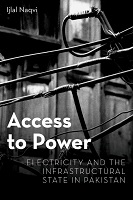Access to Power
Electricity and the Infrastructural State in Pakistan
| dc.contributor.author | Naqvi, Ijlal | |
| dc.date.accessioned | 2024-02-19T14:12:07Z | |
| dc.date.available | 2024-02-19T14:12:07Z | |
| dc.date.issued | 2022 | |
| dc.identifier | OCN: 1329430917 | |
| dc.identifier.uri | https://library.oapen.org/handle/20.500.12657/87758 | |
| dc.description.abstract | Pakistan would desperately like to produce enough electricity, but it usually doesn’t. This is the rare issue on which government and private sector can unite, and it is the cause of suffering for rich and poor alike across the entirety of the country. Despite prioritization by successive governments, targeted reforms shaped by international development actors, and featuring prominently in Chinese Belt and Road Investments, the Pakistani power sector still stifles economic and social life across the country. This book explores state capacity in Pakistan by following the material infrastructure of electricity across the provinces and down into cities and homes. It argues that the national challenges of budgetary constraints and power shortages directly result from conscious strategic decisions that are integral to Pakistan’s infrastructural state. Electricity shortages are one of the many poor governance outcomes characteristic of low- and middle-income countries. Standard development thinking points to an absence of institutions in comparison with an idealized and distant other country, with governance reform programs formulated accordingly. However, an orientation toward what Pakistan is not takes us away from how it actually functions and to whose benefit. Electricity governance in Pakistan reinforces relations of power between provinces and the federal center, contributes to the marginalization of subordinate groups in the city, and orients citizens toward a patronage-based relationship with the state through encounters with street-level bureaucrats. Looking through the lens of the electrical power sector reveals how Pakistan works, and for whom. | en_US |
| dc.language | English | en_US |
| dc.relation.ispartofseries | Modern South Asia Series | en_US |
| dc.subject.classification | thema EDItEUR::J Society and Social Sciences::JP Politics and government::JPB Comparative politics | en_US |
| dc.subject.classification | thema EDItEUR::G Reference, Information and Interdisciplinary subjects::GT Interdisciplinary studies::GTP Development studies | en_US |
| dc.subject.classification | thema EDItEUR::J Society and Social Sciences::JP Politics and government::JPQ Central / national / federal government::JPQB Central / national / federal government policies | en_US |
| dc.subject.other | state capacity, infrastructure, electricity, Pakistan, urban, ethnography, institutions, political economy, development, China–Pakistan Economic Corridor | en_US |
| dc.title | Access to Power | en_US |
| dc.title.alternative | Electricity and the Infrastructural State in Pakistan | en_US |
| dc.type | book | |
| oapen.identifier.doi | 10.1093/oso/9780197540954.001.0001 | en_US |
| oapen.relation.isPublishedBy | b9501915-cdee-4f2a-8030-9c0b187854b2 | en_US |
| oapen.relation.isFundedBy | e1e429db-0c41-4089-92cf-8aa0c1d3315f | en_US |
| oapen.relation.isbn | 9780197540954 | en_US |
| oapen.relation.isbn | 9780197540961 | en_US |
| oapen.relation.isbn | 9780197540985 | en_US |
| oapen.pages | 209 | en_US |

